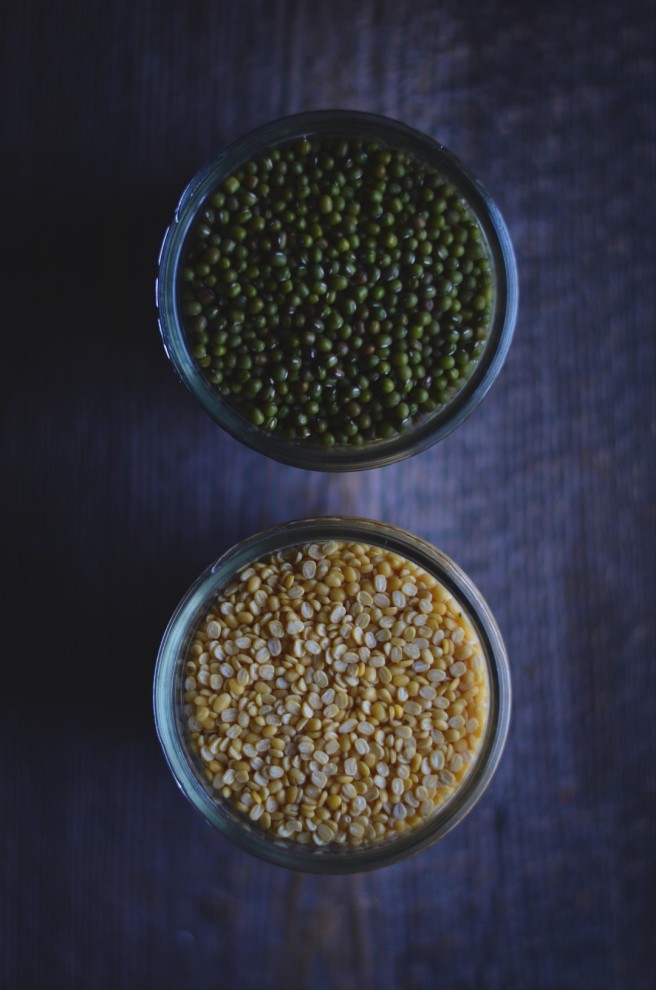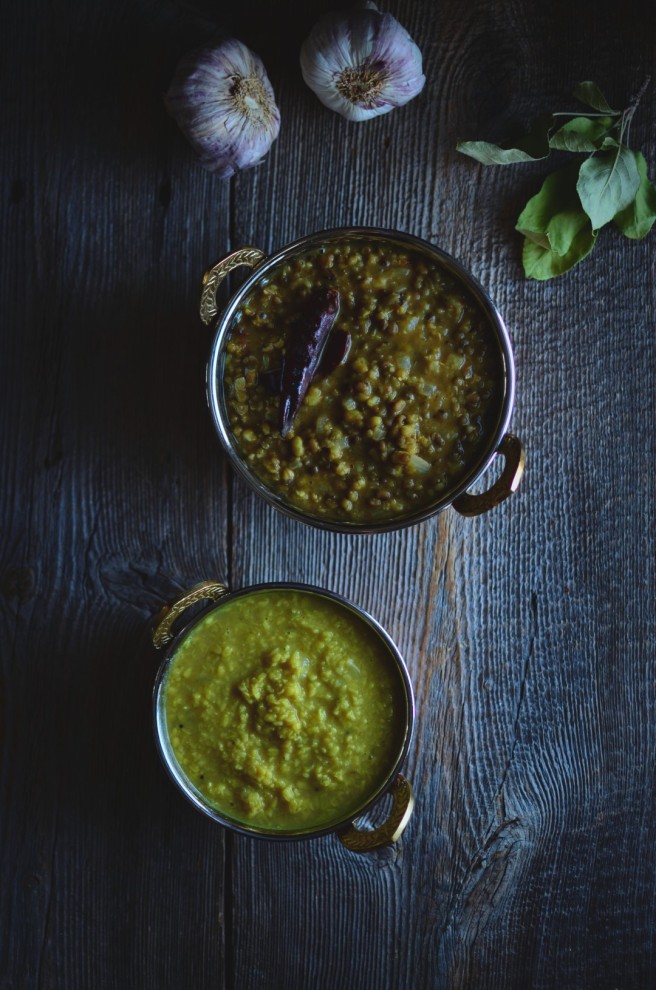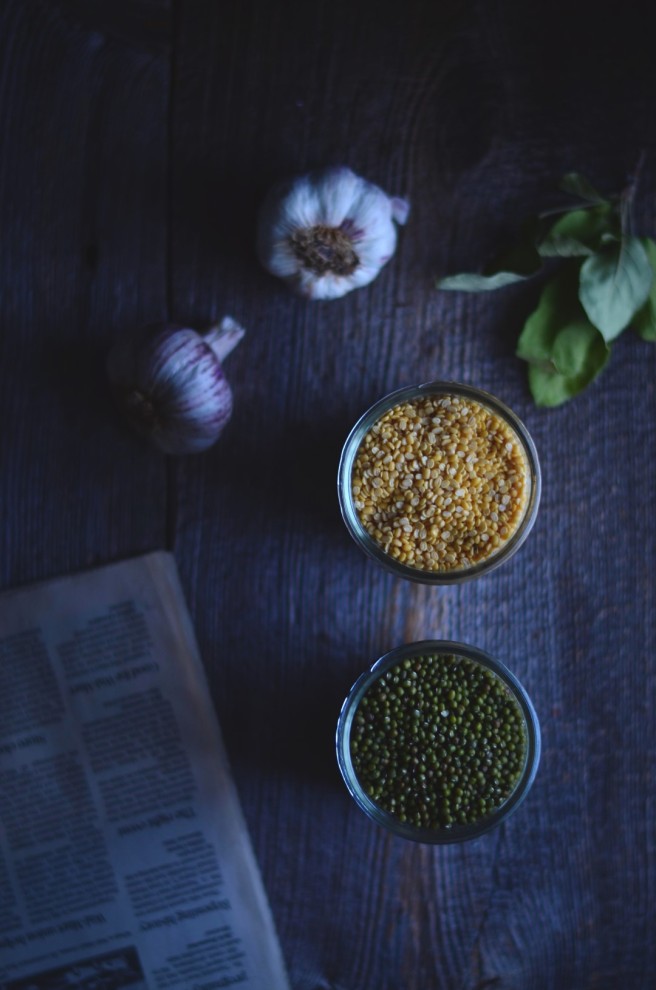The first wealth is health. —Ralph Waldo Emerson
 Growing up, dried bean curries, were my least favourite dishes (with this one exception). My parents would explain how healthy these dishes are. They would explain how dal bhat (rice and dried beans or lentils) or dal and roti are staples of the Indian diet and how they had sustained our ancestors for millennia. Furthermore, they had both grown up hearing stories of how our ancestors of not many generations ago had survived periods of drought and subsequent famine by boiling dried beans, drinking the resulting stock and setting the beans to dry again so that they may be boiled again for the next meal. It would be stories like these that would later prompt my parents to leave their beloved homeland and set new roots in a foreign but more prosperous country. They knew, as farmers, we were always two back-to-back failed monsoons away from catastrophe. To them, these little beans were not only packed with nutrition but they were at the root of our very existence as well. And it wasn’t only because of our past that we owed our existence to these dried beans, even in our present life here in Canada, my parents managed to put wholesome, nutritious meals on the table and still make ends meet due to the relatively low cost of a diet heavily based on pulses.
Growing up, dried bean curries, were my least favourite dishes (with this one exception). My parents would explain how healthy these dishes are. They would explain how dal bhat (rice and dried beans or lentils) or dal and roti are staples of the Indian diet and how they had sustained our ancestors for millennia. Furthermore, they had both grown up hearing stories of how our ancestors of not many generations ago had survived periods of drought and subsequent famine by boiling dried beans, drinking the resulting stock and setting the beans to dry again so that they may be boiled again for the next meal. It would be stories like these that would later prompt my parents to leave their beloved homeland and set new roots in a foreign but more prosperous country. They knew, as farmers, we were always two back-to-back failed monsoons away from catastrophe. To them, these little beans were not only packed with nutrition but they were at the root of our very existence as well. And it wasn’t only because of our past that we owed our existence to these dried beans, even in our present life here in Canada, my parents managed to put wholesome, nutritious meals on the table and still make ends meet due to the relatively low cost of a diet heavily based on pulses.
Sadly though, as the poor, underdeveloped India that I left behind at age three moves towards becoming a developed country, it’s also moving away from the traditional diet. I don’t believe it’s a coincidence that in unprecedented numbers, it’s population is facing dietary health issues and obesity. As for me, no matter how many years I live abroad, no matter how prosperous my life here may be, I can’t lose the common sense instilled within me about eating well and these little beans remain a staple in my family’s diet even today here in Canada.
 I’ve got two recipes below, both the authentic versions as were prepared at home. But mung beans are so versatile… spice them up as you wish, throw them in a soup or stew, replace chickpeas with them for making hummus and falafel… the possibilities are endless, as are the health benefits. Enjoy!
I’ve got two recipes below, both the authentic versions as were prepared at home. But mung beans are so versatile… spice them up as you wish, throw them in a soup or stew, replace chickpeas with them for making hummus and falafel… the possibilities are endless, as are the health benefits. Enjoy!

Whole Mung Bean Curry
(serves 4)
- 175 g whole mung beans
- 70 g (about 1 small) onion, finely chopped
- 1 tsp salt
- 1 tsp coriander powder
- 1 tsp cumin powder
- 1/4 tsp turmeric
- 1/4 tsp garam masala
- 1/2 fresh green chili, minced, seeds removed (adjust to taste)
- 1/4 tsp red chili powder (adjust to taste, optional)
- 20 g olive oil
- 1/4 tsp fenugreek (methi) seeds
- 1/4 tsp black mustard (rai) seeds
- 2 whole dried red chilis
- 1 small garlic clove, thinly sliced
- 80 g (about 1 small) tomato, finely chopped
- Wash and rinse mung beans and set to soak for about 4 hours.
- Drain mung beans and add to a medium-sized pot along with onions and about 700 g cold water.
- Bring to a boil and continue to simmer for 20-25 minutes, until the beans are cooked and skin of the beans is cracked.
- Stir salt, cumin and coriander powder, turmeric, garam masala, green chili and red chili powder. Set aside.
- Traditionally a kadai (or karahi) is used but you may use a large pot or a wok for this step. On high heat, heat the 20 g of oil.
- Add fenugreek and mustard seeds to the oil and allow them to start crackling.
- Add whole red chilies, wait a few seconds and add garlic slices and allow them to brown slightly.
- Add tomato, lower heat to medium, cover and cook for about 3 minutes.
- Add the cooked bean mixture and bring to a boil. You may add some water if too dry.
- Simmer for about 10 minutes or longer if you would like to thicken the curry.
- Serve hot with rice or roti.
Yellow Mung Bean Curry
(serves 2-3)
- 110 g (about 1/2 cup) split mung beans
- 45 g onion, finely minced
- 1 small garlic clove, finely minced
- 1/2 fresh small green chili, minced, seeds removed (adjust to taste)
- 1 tsp salt
- 1 tsp coriander powder
- 1 tsp cumin powder
- 1/4 tsp turmeric
- 1/4 tsp garam masala
- 1/4 tsp red chili powder (adjust to taste)
- 2 tbsp olive oil
- 1/4 tsp fenugreek (methi) seeds
- 1/4 tsp black mustard (rai) seeds
- Wash and rinse mung beans.
- In a small bowl, add beans, onions, garlic and chili, as well as the salt and all the spices.
- Traditionally a kadai (or karahi) is used but you may use a medium-sized pot or a wok for this step. On high heat, heat the oil.
- Add fenugreek and mustard seeds to the oil and allow them to start crackling.
- Add the bean mixture, along with 240 g of cold water.
- Cover and cook on low-medium heat for about 20-25 minutes. The beans should be cooked thoroughly. Half way, if it looks too dry, add a few tablespoons of water or leave it as a dry curry depending on your preference.
- Serve hot with rice or roti.

Nice Clicks!!
Thank you so much dear!
Love how your photographs bring even something as basic as moong dal to another level! The meat eater that I am, my all time comfort food remains mungdal khichdi 🙂
I am so happy to hear that, I will pass this on to my meat-eating husband! Thank you for your wonderful comment.
🙂
Love to visit you’re blog Annika, not only see it at Instagram;-) Beautiful photos!
Oh how sweet you are. Thank you so much for visiting. Just took a quick look at your blog and it’s so gorgeous. Will have to sit with a cup of tea (or usually pot of tea in my case!) and go through it all!
Lovely recipes Annika and i haven’t been to India for a few years – but can see how their move to a western processed and fast food diet will quickly take its toll. Such a shame when authentic Indian cooking is so darn good!
Thank you dear. It really is a shame. I try really hard to pass down the traditional food to my children… interestingly, they really do love it, they are not fans of fast food at all.
Lovely post Annika. I will try cooking with mung beans now ☺
Thank you and your body will thank you too.
☺😉
It’s nice to hear the stories about how you grew up with these foods. Glad you’re keeping them alive and sharing your traditions with us! Thanks!
Thank you so much.
As always, looks good. 🙂
Thank you Rini!
Thank you for this. We stock up on mung beans in bulk to sprout, but I never know what else to do with them!
I usually sprout them as well and that’s how my kids prefer them. These are traditional authentic recipes, well worth preserving and carrying forward, I do hope you like them.
I looooove whole mung beans – I actually love any kind of pulses and beans with the exception of fava beans or broad beans as they are usually called – but never saw the other ones, it is hard enough to find whole mung beans here in Portugal, but when I do, I stock up, as well as azuki beans and lentils. Gonna bookmark these recipes for later reference for sure, I tend to do very simple stews with my beans and this is a different take that I’m sure I will adore.
I’m a big fan of pulses. I will check our your blog for Portuguese pulse recipes. I hope you will like mine. xx
Wonderful ! Like these healthy hearty mung beans curry !!
Thank you. They are so underrated I find.
These looks delicious, Annika. I love the way you put them in perspective. When I come home to Calcutta — I am here right now — I cull recipes from the kitchen because my mother does make the most delicious veggie dishes. I do not know why I did not try them out in mine before. xx
I know what you mean… no matter how hard I try, I can never match my parents’ expertise in the kitchen. Thank you for stopping by.
My pleasure always 🙂 I am enjoying home cooking way better than eating out! xx
You’re so right. It’s sad people abandon their healthy cuisine for commercial unhealthy one. We definitely need to put the effort into preserving such recipes and flavors. Both dishes look so tasty and hearty. 🙂
Thank you darling. I totally agree with you. For this reason, I put recipes like these up here… surely not ones that make you a popular blogger but well worth preserving and eating! xx
Super delicious and love to have curry with bajra roti.. awesome share Annika 🙂👍
Agreed, I don’t make bajra roti often but so perfect with dal. Thank you.
Love your stories Annika! Your pictures are lovely and the recipes are amazing, love Indian cuisine, so flavorful and healthy!
Thank you Ursula! xx